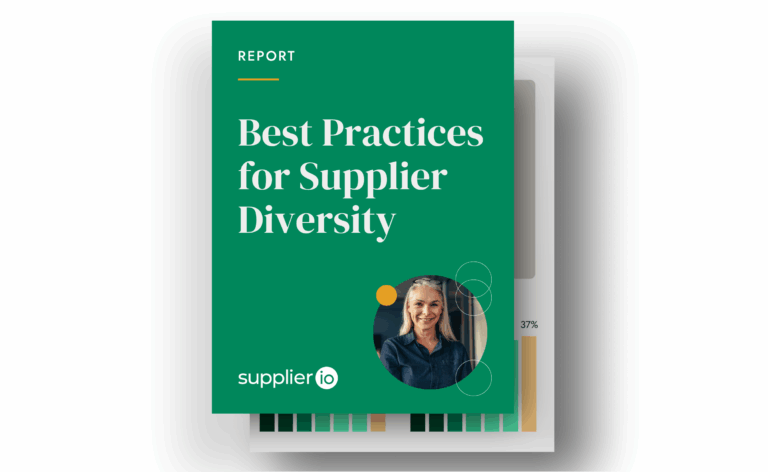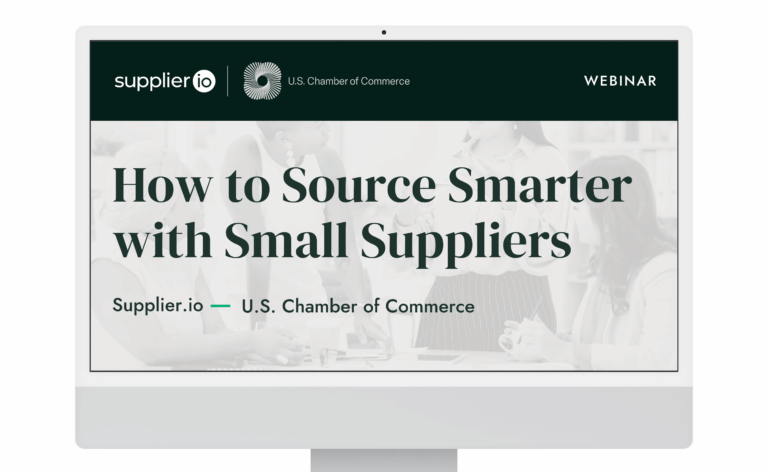Key Trends for Supplier Diversity Programs and Procurement Teams in 2025
How cost, sustainability, AI, and shifting economic policies are reshaping supplier diversity programs.

As we look to 2025, supplier diversity programs and procurement teams are bracing for a year of both opportunity and uncertainty.
While top business priorities like cost reduction, risk management, and sustainability remain steady, new economic policies, tariffs, and geopolitical changes are adding new complexity to supply chain strategies.
Supplier.io recently hosted a webinar on the expected trends for 2025 with Aylin Basom, CEO of Supplier.io and Chris Sawchuk, Principal and Global Procurement Advisory Practice Leader at The Hackett Group. They spent an hour exploring some of the major trends, priorities, and opportunities leaders need to prepare for in 2025.
According to Chris Sawchuk, “A continued focus on cost, combined with shifting policies and global trade dynamics, will force procurement teams to rethink their operating models and supply chain resilience.”
At the same time, supplier diversity programs continue to provide value—helping businesses navigate uncertainty, unlock alternative sourcing opportunities, and demonstrate measurable economic impact. Aylin Basom, emphasized, “Supplier diversity isn’t just about values—it’s about competitiveness, resilience, and tangible business growth.”
The key trends that will shape supplier diversity programs and procurement strategies in 2025 are:
1. Cost reduction and supply chain resilience take center stage
In 2025, cost reduction remains the top priority for procurement leaders worldwide, driven by persistent inflation, supply chain disruptions, and shifting global trade policies. Chris Sawchuk noted, “The focus on cost will be even more pronounced next year as organizations continue to look for efficiencies in their supply chains.”
Compounding this challenge, organizations are also preparing for new economic policies and tariffs. Aylin Basom highlighted this shift:
“Procurement leaders are anticipating new tariffs and trade challenges, which will prompt a closer look at nearshoring, local sourcing, and supplier diversification to mitigate supply chain risks.”
This is where a strong supplier diversity program comes into play. Small and diverse suppliers can help organizations build more agile, resilient supply chains by offering alternative sourcing options and local solutions.
For instance, during the pandemic, companies with diverse supplier networks weathered disruptions more effectively. Basom emphasized, “Supplier diversity programs are essential for mitigating risk and ensuring continuity, especially as geopolitical and economic uncertainties persist into 2025.”
2. Demonstrating business value becomes non-negotiable
In today’s climate, supplier diversity programs are no longer viewed as a “nice-to-have”—they’re recognized as drivers of measurable business outcomes. Supplier.io’s latest State of Supplier Diversity research revealed a key trend:
47% of companies reported that supplier diversity programs helped win more RFPs and drive revenue growth.
Organizations are also leveraging supplier diversity programs to reduce costs and support competitive supply chains. Diverse suppliers, on average, boast a 20% higher retention rate, providing stability in uncertain markets.
“The business case for supplier diversity programs has never been stronger,” Basom emphasized. “It’s about bottom-line growth, supply chain competitiveness, and brand differentiation.”
Supplier diversity professionals must focus on showcasing these outcomes. Tracking metrics like cost savings, RFP wins, and economic impact will be critical to securing executive buy-in and demonstrating program value.
3. Data accuracy and reporting are more critical than ever
Accurate data is the foundation of a successful supplier diversity program. Many organizations are turning to supplier data management software to centralize and validate supplier information, making it easier to track progress and ensure reporting accuracy. As organizations face increased scrutiny—from both executives and external stakeholders—leaders must prioritize clean, validated data to measure and communicate program performance effectively.
Aylin Basom pointed to growing executive visibility:
“CEO-level support for supplier diversity programs has doubled in recent years. More than half of supplier diversity leaders now report regularly to the CEO or board of directors.”
This increased visibility underscores the need for supplier diversity professionals to have reliable data at their fingertips. From spend analytics to impact measurements, reporting must be accurate, actionable, and aligned with enterprise goals.
Supplier diversity leaders should also leverage their data to collaborate with business unit leaders—a trend that will continue to grow in 2025. According to Supplier.io, 66% of supplier diversity leaders now spend half or more of their time partnering with business counterparts.
4. Measuring impact beyond spend
While tracking spend remains a cornerstone of supplier diversity programs, organizations are expanding their focus to include broader impact metrics. Economic impact analysis, in particular, is gaining momentum:
- In 2022, only 10% of organizations conducted economic impact studies.
- By 2024, that number surged to 37%, with further growth expected in 2025.
Supplier.io’s upcoming Total Economic Impact Report reveals the tangible benefits of supplier diversity programs. Collectively, Supplier.io customers spent $170 billion with small and diverse suppliers, supporting over 1.4 million jobs.
“This data is incredibly powerful,” Basom noted. “It’s what gets the attention of CEOs, board members, and local governments. It’s about showing the real economic value of supplier diversity programs.”
By measuring metrics like job creation, GDP contributions, and community impacts, supplier diversity professionals can demonstrate how their programs drive both business and societal outcomes.
5. Sustainability and supplier diversity programs are converging
Sustainability continues to rise as a priority for procurement teams. In 2025, supplier diversity programs will increasingly align with broader Environmental, Social, and Governance (ESG) initiatives.
Supplier.io’s research revealed that 80% of organizations view ESG as a key enabler of supplier diversity programs. Businesses are focusing on:
- Identifying and partnering with sustainable suppliers.
- Measuring supply chain emissions.
- Demonstrating local economic impacts through responsible sourcing.
Chris Sawchuk noted that sustainability is becoming part of the procurement transformation agenda:
“Companies are broadening their focus beyond profit to include environmental and social outcomes. This creates a natural alignment between supplier diversity and sustainability goals.”
Organizations that integrate supplier diversity into their ESG strategies will be better positioned to meet regulatory requirements, strengthen brand equity, and drive long-term value.
6. Generative AI accelerates transformation
Artificial intelligence—particularly generative AI—will play a transformative role in procurement and supplier diversity programs in 2025. Chris Sawchuk shared insights from The Hackett Group’s research:
“Generative AI is already being deployed in areas like spend analytics and contract lifecycle management. Adoption will accelerate as organizations look to blend human expertise with technology to drive efficiencies.”
For supplier diversity leaders, AI presents opportunities to:
- Streamline data analysis and reporting.
- Identify diverse suppliers more efficiently.
- Enhance visibility into supplier performance and impact.
This means supplier diversity leaders need to leverage technology to track and monitor program success and instead focus on business relationships and value add opportunities.
Preparing your supplier diversity program for 2025
The trends shaping 2025—cost pressures, geopolitical shifts, sustainability goals, and AI—create both challenges and opportunities for supplier diversity programs. Leaders who align their programs with enterprise priorities, invest in accurate data, and measure meaningful impact will be best positioned to thrive.
As Aylin Basom put it: “Supplier diversity programs are a must-have. Leaders who adapt to changing dynamics and showcase their business value will drive success for their organizations and their communities.”
Want to strengthen your supplier diversity program for 2025? Supplier.io provides the data, tools, and expertise to help you measure impact, enhance reporting, and drive results. Contact our team today to learn more.hen operations and create value, ensuring their supply chains remain sustainable, efficient, and adaptable for the future.





